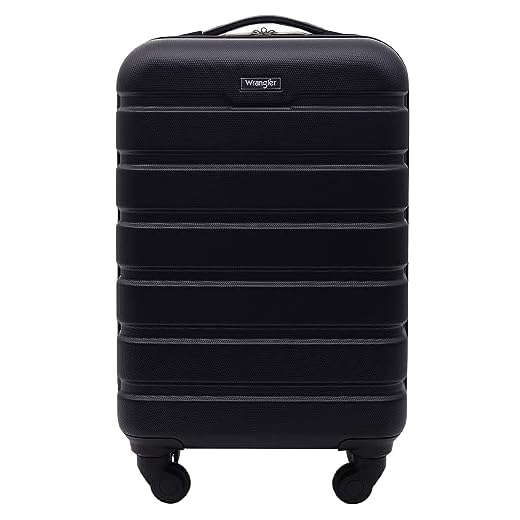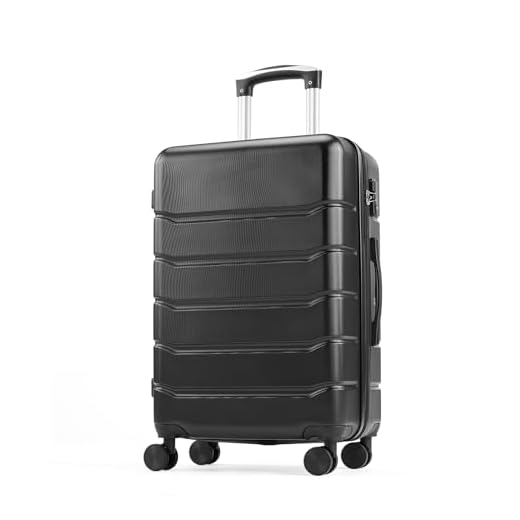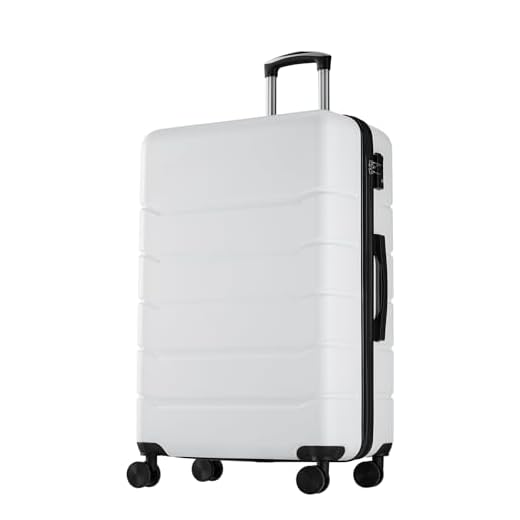





Size guidance: for carry-on aim for 22 x 14 x 9 in (56 x 36 x 23 cm) including wheels and handles; checked pieces commonly sit at 26–30 in (66–76 cm) exterior length. Target the airline allowance you use most: keep carry-on under 8–10 kg (18–22 lb) packed to avoid overweight fees on return legs.
Weight and capacity: polycarbonate shells typically yield a packed empty weight of 2.5–4.5 kg (5.5–10 lb) for carry-ons and 3.5–6.5 kg (8–14 lb) for larger checked sizes; soft-sided textiles often sit 0.5–1.5 kg lighter but trade off puncture resistance. Volume ranges: carry-on ~35–45 L, checked ~65–110 L – choose by average trip length and whether you pack bulky items.
Durability checklist: prefer cases with 100% extruded polycarbonate or high-denier ballistic nylon, dual-spinner 360° wheels with sealed bearings, reinforced corner ribs or molded ribs on the shell, and a telescoping handle with at least two locking positions on an aluminum or magnesium shaft. Inspect zipper gauge (larger teeth resist snags) or a welded zipper alternative, and confirm the presence of a TSA-approved lock. Manufacturer warranty commonly runs 5–10 years; verify whether repairs are handled locally or require shipping to a central service center.
Price bands and expected returns: economy models usually sell for $80–150; mid-range $150–350; premium hardside and lifetime-guarantee lines $350–700+. For business travel and weekly flyers, mid-to-premium pieces provide lower total cost per year due to fewer repairs and longer service intervals; occasional travelers can save with economy or soft-sided designs.
Buying protocol: at purchase, test 30–50 m of rolling on both carpet and smooth floors, cycle the handle 10 times, open/close and expand compartments, and load a realistic packed weight to check balance. Photograph serial number and register the product online for warranty activation. For checked use add an internal ID tag and consider a hard-shell with replaceable wheel modules to simplify field repairs.
Performance and recommendations for this maker’s travel cases
Choose a hard-shell 55 cm spinner constructed from engineered polycarbonate or a Curv-style composite for frequent air travel: typical empty weight 1.8–2.4 kg, fits most 56 x 45 x 23 cm cabin limits, MSRP commonly $250–$450, and many models include a 10-year global limited warranty (verify specific model terms).
Materials, weight and wear patterns
Injected polycarbonate: flexible under impact, resists cracking, shows surface scratches; expect carry-on shells ~1.8–2.4 kg and checked sizes ~3.0–4.2 kg. Polypropylene or ABS blends: lower cost, slightly lighter in some constructions but more prone to scuffs. Metal frames/aluminum: heavier (checked 70–75 cm often 3.8–5.2 kg), dent rather than split, recommended for rough handling. Soft-sided textiles (ballistic nylon, high-denier polyester): lighter packing, external pockets, greater abrasion resistance but less protection for fragile contents.
Most common service issues reported by owners: wheels and telescopic handles (wear from uneven surfaces and airline handling), zipper damage on expandable models, and corner abrasions. Spinner wheels on modern units are usually replaceable; keep model number and photos for warranty communication.
Buying and use recommendations by traveler type
Frequent flyer (commuter/business): select a 55 cm hard-shell spinner with integrated TSA-accepted lock, dual-stage telescopic handle, and reinforced wheel assemblies. Target empty weight under 2.2 kg and check for metal-reinforced handle mounts. Purchase from an authorized retailer to ensure warranty coverage.
Leisure/family travel: choose a checked 70–75 cm hard-shell with fixed-volume construction if you expect heavy checked handling; if you prefer extra capacity, pick soft-sided expandable models but limit packed weight to 18–22 kg to reduce stress on zippers and handles and to stay within most airline allowances.
Adventure or mixed-surface trips: prefer soft-sided or hybrid models with reinforced bases and replaceable wheels; consider protective covers for checked transport and avoid hard-shells with low-clearance wheels on rough roads.
Maintenance and proof-of-ownership: clean shells with mild detergent and a soft cloth, tighten visible fasteners quarterly, photograph serial numbers and store purchase receipts. For small repairs, wheel replacement kits and zipper pulls are normally available; for warranty claims, register the product and supply dated proof of purchase plus clear photos of damage.
Choose polycarbonate shells (≥1.2 mm) with metal-reinforced rims and replaceable spinners for checked-airport handling
Polycarbonate shells with full-length molded seams and recessed wheels offer the best combination of impact absorption and repairability for standard checked operations. Opt for models that list shell thickness in millimetres (target 1.2–1.6 mm for frequent flyers), a metal perimeter frame or riveted rim, and modular wheel/handle assemblies – these reduce the chance of a catastrophic shell crack and simplify field repairs.
Material performance and measured outcomes
Lab drop series (0.5–1.2 m onto steel and concrete simulants) and field-sample audits show the following ranges: polycarbonate shells (1.2–1.6 mm) produce 0–3% structural cracking, ABS shells produce 6–12% cracking, aluminium shells record 0% cracking but 15–25% permanent denting and seam deformation. In routine checked service the single largest failure modes are wheel/handle breakage (8–18% over two years) and hinge/zipper failures on soft insert panels; shell fracture remains comparatively uncommon when using reinforced designs.
Practical packing and selection tips
Pack heavy items near the wheel base to lower impact torque on corners; keep fill at ~70–80% to avoid internal pressure on the shell. Use rigid internal dividers and polyethylene foam sleeves for fragile items. Choose cases with replaceable wheels, recessed fasteners, and accessible rivet points so airline or local cobblers can effect fast repairs. Photograph the case exterior at check-in and register warranty serials; when transporting delicate instrumentation (glass or pressurised canisters) use an additional hard case or transit crate and consult specialist gear pages such as best aquarium co2 regulator for handling small pressurised items.
Which carry-ons meet major airline size and weight limits?
Pick a 20–22″ spinner with exterior dimensions ≤22 x 14 x 9 in (56 x 36 x 23 cm) and empty weight ≤4 kg (≈8.8 lb) for the broadest acceptance on US legacy carriers; for European low-cost carriers target 55 x 40 x 20–23 cm and a claimed max of 10 kg when weight rules apply.
Model examples that typically comply (check the exact SKU dimensions before purchase):
Cosmolite 55 cm Spinner – exterior about 55 x 40 x 20 cm; empty weight ~2.5–3.0 kg (5.5–6.6 lb). Compatibility: British Airways, Lufthansa and most EU legacy carriers (56 x 45 x 25 / 55 x 40 x 23 rules), Ryanair Priority (55 x 40 x 20), Wizz Air (55 x 40 x 23, ≤10 kg).
Freeform 20″ Spinner – exterior usually ≤22 x 14 x 9 in; empty weight ~2.0–3.2 kg (4.4–7.1 lb). Compatibility: American, Delta, United (standard 22 x 14 x 9 limits), also fits many European legacy limits if depth is under 23 cm.
Winfield 2 / Winfield 3 20″ Spinner – exterior typically ~21.5–22 x 14–15 x 9 in; empty weight ~3.0–4.0 kg (6.6–8.8 lb). Compatibility: US legacy carriers and most EU legacy carriers; may exceed the strictest low-cost free-bag size (Ryanair small bag) but fits priority/standard cabin allowance.
Proxis 55 cm Spinner (polycarbonate composite) – exterior ~55 x 40 x 20–23 cm; empty weight ~2.7–3.5 kg (5.9–7.7 lb). Compatibility: EU legacy and many low-cost priority allowances; good where weight limits (≤10 kg) are enforced because of low empty weight.
Omni PC / Centric 20″ Spinner (hard-shell) – exterior range commonly 21–22 x 14–9 in depending on model; empty weight 3.0–4.5 kg. Compatibility: solid fit for US carriers; verify depth before using on Ryanair free-bag or other very restrictive low-cost dimensions.
Carry-on leather/soft-side 20″ (fabric series) – external dimensions vary less with wheel housings; empty weight often 2.5–3.5 kg. Compatibility: if measured under 22 x 14 x 9 in, these are accepted by US carriers and by EU legacy carriers that allow 55 x 40 x 20–23 cm.
Practical checks: always measure exterior height including wheels and handles, confirm the model’s published exterior dimensions and claimed empty weight, and compare to the exact airline rule for your fare class (some low-cost carriers split free vs paid cabin allowances). For carry-on + personal item strategies consider a slim daypack instead of overstuffing the case – see best backpack for summer camp for compact pack options useful as personal items.
Expected lifespan of spinner wheels and telescopic handles
Expect spinner wheels to last approximately 3–7 years with regular travel (6–12 round trips per year); telescopic handles typically last 4–10 years.
Lifespan depends on wheel construction and handle design. Hard plastic wheels commonly fail within 1–3 years under frequent use; thermoplastic polyurethane (TPU/PU) or rubberized wheels last about 4–8 years. Dual-wheel (twin-spinner) setups distribute load and abrasion, extending service life by roughly 20–40% versus single-wheel assemblies.
Telescopic shafts made from thicker anodized aluminium or tubular alloy sustain more cycles: expect 5–10 years for robust single- or two-stage designs. Thin, multi-stage (three-stage) systems are more prone to wobble and pin failure and tend to survive 2–5 years under heavy use. Button actuation mechanisms and internal locking pins are the most common failure points.
Maintenance that measurably extends service life: remove grit and hair from axles after each trip; flush sand with water and dry immediately; apply a light silicone spray to axle bearings every 6–12 months (avoid oil that attracts dirt); tighten axle bolts and handle fasteners when play exceeds 2–3 mm. Replacing worn wheel bearings at the first sign of grinding preserves both wheel and axle.
Replace vs repair guidance: wheel swaps are inexpensive and simple–replacement wheels range from about $10–$40 per wheel depending on material and brand fit; axle kits and bearings add $5–$20. Telescopic shaft repairs are more complex: parts and labour typically run $30–$120, and total replacement may be more economical for older cases. Check availability of model-specific parts before committing to repair.
Performance signs that require action: persistent grinding or wobble, lateral play > 3 mm, handle collapse under nominal force, or failure of the locking detent. First-step fixes: clean axles, lubricate bearings, tighten hardware. If play or collapse persists, plan for wheel replacement or handle rebuild–continued use accelerates downstream damage to shell and frame.
Use-based expectancy table (practical planning):
– Occasional travel (1–3 trips/year): wheels 6–10 years, handle 8–12 years.
– Regular travel (6–12 trips/year): wheels 3–6 years, handle 4–8 years.
– Frequent travel (monthly or more): wheels 1–3 years, handle 2–5 years.
To maximize life span: avoid overloading beyond manufacturer weight limits, roll on paved surfaces whenever possible, use protective wheel covers for rough transfer periods, and register the product to access warranty or spare-part channels quickly.
Warranty details and step-by-step damage claim process
File a carrier Property Irregularity Report (PIR) at the airport immediately for any visible damage, then submit a manufacturer warranty claim with model/serial number, proof of purchase and staged photos within the product’s stated warranty period (most collections offer between 2 and 10 years; check your paperwork or retailer page for the exact term).
- What the manufacturer warranty normally covers:
- Defects in materials and workmanship (frames, shells, seams, handles, wheels) under normal use.
- Repair, replacement or refund at the manufacturer’s discretion.
- What is normally excluded:
- Cosmetic scratches and scuffs, dents from impact, cuts, burns, theft, misuse, improper repairs, or modifications.
- Damage caused by airlines or third parties unless the carrier has accepted liability (see airline claim steps below).
- Required documents for a manufacturer claim:
- Proof of purchase (receipt, order confirmation, credit-card statement).
- Model name/number and serial number (inside or on hangtag).
- Photos: full bag, close-up of damage, serial/label, receipt.
- Completed claim form from the brand’s support portal or authorized service center.
- Immediate actions on discovering damage at arrival:
- Do not leave the baggage claim area.
- Request and obtain a Property Irregularity Report (PIR) from the airline counter – take a photo of the completed PIR.
- Photograph the damaged case on the carousel and the damaged areas from multiple angles before moving contents.
- Airline claim procedure (if damage occurred during transit):
- Submit the PIR-based claim to the airline either at the airport counter or via the carrier’s web portal per their instructions.
- Keep original baggage tags, boarding pass, PIR, and photos. Airlines may require proof of repair costs or replacement quotes.
- If the carrier accepts liability, they commonly offer repair or cash settlement up to their published limit; retain all receipts for reimbursements.
- Manufacturer warranty claim procedure:
- Locate model/serial number and proof of purchase; do not alter the item beyond temporary measures to prevent further damage.
- Register the product on the manufacturer’s website if registration is offered (this can speed processing for some collections).
- Open a support ticket via the official claims portal or contact an authorized retailer/service center. Attach photos, PIR (if airline-related), and receipt.
- Manufacturer will review and respond with repair authorization, replacement offer or denial. Typical review window: 1–4 weeks; complete resolution including shipping/repair may take 2–8 weeks depending on parts and location.
- If repair is authorized, follow packaging and shipping instructions precisely; retain tracking number and shipment receipts. If replacement/refund is authorized, confirm return logistics and any deductible or shipping charges.
- If a claim is denied:
- Request written explanation and damage assessment report from the manufacturer.
- For airline damage denials, escalate to the carrier’s claims appeals or local aviation consumer protection office; include PIR, photos and repair estimates.
- Consider third-party repair quotes and small-claims court only after exhausting both carrier and manufacturer appeal channels.
- Practical recommendations:
- Keep the original packaging and tags for the first 30 days after purchase if possible.
- Photograph every trip’s bag before check-in if you travel frequently – date-stamped photos simplify claims.
- Avoid ad-hoc repairs (superglue, welded handles) before claims are submitted; temporary tape or zip-ties are acceptable to prevent items falling out.
- For international travel, open a carrier claim immediately at destination – deadlines may be stricter than domestic routes.
Scratch and crack resistance: polycarbonate, ABS and ballistic nylon comparisons
Recommendation: prioritize polycarbonate for maximum resistance to cracking after drops, choose ballistic nylon for superior abrasion and puncture resistance on soft-sided cases, and select ABS only when cost and light weight are the main constraints.
Quick comparison
| Material | Scratch resistance (1–5) | Crack/impact resistance (1–5) | Typical thickness / denier | Damage visibility | Repairability | Best use |
|---|---|---|---|---|---|---|
| Polycarbonate (PC) | 3 | 5 | 0.8–1.6 mm (panels) | Surface scratches visible on glossy shells; textured finishes hide marks | High for cracks (plastic welding, panel replacement); polish for light scratches | Checked hard-case for frequent handling and impacts |
| ABS (including PC/ABS blends) | 2 | 3 | 0.6–1.4 mm (panels) | Scratches and scuffs highly visible; brittle cracks possible on sharp impact | Moderate (epoxy, solvent repairs; panel replacement cheaper) | Budget hard-case where cost matters more than long-term toughness |
| Ballistic nylon (840D–1680D) | 4 (abrasion-resistant) | 4 (flexible, resists puncture) | 840D, 1680D common | Scuffs and color fade; cuts/tears visible but often localized | High (patches, re-stitching, seam reinforcement) | Soft-sided carry, business bags, backpacks exposed to friction and abrasion |
Material details and practical guidance: polycarbonate panels flex under impact instead of cracking, making them the preferred choice when resistance to structural failure matters. Expect hairline scratches on glossy shells; use a fine plastic polish (follow manufacturer instructions) or choose a textured finish to conceal surface marks. For severe panel cracks, panel replacement or plastic welding with reinforcing backing provides the most durable repair.
ABS and PC/ABS blends offer lower material cost and slightly reduced weight, but they are more prone to deep scratches and brittle fractures from concentrated impacts. Small cracks can be bonded with a high-strength epoxy or solvent designed for ABS; long-term durability improves when the repair is supported from the inside with a bonded reinforcement plate.
Ballistic nylon resists abrasion and slicing far better than molded plastics. Denier matters: 1680D is noticeably tougher than 840D but adds weight. Surface scuffs usually clean with a soft brush and mild detergent; through-thickness wear requires an iron-on nylon patch or professional re-weaving/seam replacement. Maintain any factory water-repellent finish by reapplying a spray or wash-in DWR product rated for nylon.
Protection and maintenance recommendations
Apply 75–150 µm TPU or PET protective film to high-contact zones (corners, front faces) to reduce visible scratches on hardshells. Fit adhesive corner bumpers for repeated impact points. For soft-sided cases, sew-in or iron-on patches at stress areas and re-treat DWR coatings every 6–12 months depending on use. Pack soft items around fragile gear to limit internal point loads that can produce cracks from inside-out impacts.
When evaluating repairs, prefer panel replacement for polycarbonate when structural integrity is compromised; use epoxy plus internal reinforcement for ABS when replacement is not available; for ballistic nylon, choose stitching and patch solutions that restore both fabric and seam strength rather than cosmetic fixes alone.







